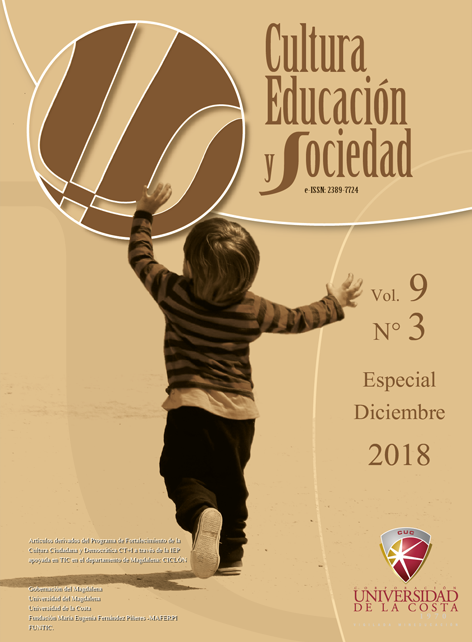The newspaper "El coquillo" as a pedagogical strategy to strengthen the critical thinking of students
DOI:
https://doi.org/10.17981/cultedusoc.9.3.2018.70Keywords:
Reading process, critical reading, knowledge, teaching.Abstract
Reading is an important source of knowledge, which is why it is widely promoted in schools. The purpose of this research is to strengthen critical thinking through the newspaper El Coquillo in the sixth grade students of the Educational Institution Celinda Mejía López. As instruments of information collection, observation, survey and interview were used. The majority of students affirm that the variety in the texts assigned for the reading affects highly in their desire to read, as for the types of reading the narrative stands out among the other options. Variety greatly influences the processes of meaningful teaching because through this the student's interest in reading is aroused and it is achieved that they acquire a critical reading process, which is one of the competencies that are evaluated in great quantity. of state tests.
Downloads
References
Almeida, M., Coral, F., Ruiz, M y Grisales, M. (2014). Didáctica Problematizadora para la configuración del Pensamiento Crítico en el marco de la atención a la diversidad (Tesis de pregrado). Recuperado de: http://ridum.umanizales.edu.co:8080/jspui/bitstream /6789/1727/1/TESIS%20DE%20GRADO.pdf
Arrieta, M. (2016). Los masones en el mundo: Geopolítica masónica. La historia de los hijos de la luz. Córdoba, España: Editorial Almuzara.
APA. (1990). Critical Thinking: A Statement of Expert Consensus for Purposes of Educational Assessment and Instruction. The Delphi Research Report. American Philosophical Association. Recuperado de: http://www.insightassessment.com/dex.html
Bailin, S., Case, R., Coombs, J. R y Daniels, L. B. (1999). Conceptualizing critical thinking. Journal of curriculum studies, 31(3), 285-302. Recuperado de: http://www.iskconeducation.org/download/BAILIN,CASE,COOMBS%20&%20DANIELS%20-%20Conceptualizing%20critical%20thinking.pdf
Baqueriza, C y Anchundia, O. (2013). Aplicación de lectura crítica en los procesos de enseñanza-aprendizaje para los estudiantes de segundo año especialización lengua y literatura. Facultad de filosofía de la Universidad de Guayaquil. Propuesta guía de métodos andragógicos (Tesis de posgrado). Recuperado de: http://studylib.es/doc/3674627/tesis-carmen-baquerizo.pdf
Bierman, A y Assali, R., (1996). The critical thinking handbook. Upper Saddle River, NJ: Prentice Hall.
De Zubiría Samper, Julián. (2014). Las razones del bajo desempeño en las pruebas PISA. Recuperado de: http://www.eltiempo.com/vida-de-hoy/educacion/las-razones-delbajo- desempeno-en-las-pruebas-pisa_13789475-4
Ennis, R. H. (1987). A taxonomy of critical thinking dispositions and abilities. En J. B. Baron, y R. J. Sternberg (Eds.), Teaching Thinking Skills, New York, USA: Freeman and Company.
Facione, P y Facione, N. (1992). The California Critical Thinking Dispositions Inventory (CCTDI); and the CCTDI Test Manual. Millbrae, CA: The California Academic Press. Recuperado de: https://www.healio.com/nursing/journals/jne/1994-10-33-8 /%7B56656ba5-a555-475a-820b-fda748c578e3%7D/critical-thinking-disposition-as-a-measure-of-competent-clinical-judgment-the-development-of-the-california-critical-thinking-disposition-inventory#divReadThis
Fowler, B. (1997). Longview Community College, Critical thinking Across the Curriculum Project, Critical Thinking Definitions. Recuperado de: http://isites.harvard.edu/fs/docs/icb.topic204027.files/Critical_thinking_d efinitions.pdf.
González, M. (2008). Competencias Genéricas y formación profesional: un análisis desde la docencia universitaria. Revista Iberoamericana de educación. Recuperado de: https://dialnet.unirioja.es/servlet/articulo?codigo=2736795pae
Halpern. (1998). Knought and Knowledge: An introduction to critical thinking. Mahwah, N. J., USA: Lawrence Erlbaum.
López, G. (2012). Pensamiento crítico en el aula. Docencia e Investigación. Número 22, pp. 41-60.
López, L. (2011). La Clase Para Pensar. Editorial: Ediciones Uninorte ISBN: 978-958-741-056-3 v. 1 pp. 175.
Martínez, J. (2011). Métodos de investigación cualitativa. SILOGISMO, (08). Recuperado de: http://www.cide.edu.co/doc/investigacion/3.%20metodos%20de%20investigacion.pdf
McPeck, J. (1981). Critical Thinking and Education (El Pensamiento crítico y la Educación). Oxford. St. Martin’s Press.
Mendosa, P. (2015). La investigación y el desarrollo de pensamiento crítico en estudiantes universitarios. Tesis Doctoral. Publicaciones y Divulgación Científica. Universidad de Málaga. 194p.
Montoya, J y Monsalve, J. (2008). Estrategias didácticas para fomentar el pensamiento crítico en el aula. Revista Virtual Universidad Católica del Norte. 1-25p.
Morán, A y Uzcátegui, A. (2006). Estrategias para el desarrollo de la comprensión lectora de los estudiantes del octavo grado de educación básica. Revista de Artes y Humanidades Unica, 7 (16). Recuperado de: http://www.redalyc.org/html/1701/170118726003/
Norris, S. P. (1992). Testing for the disposition to think critically. Informal Logic, 2 (3), 157-164.
Páez, R y Rondón, G. (2014). La lectura crítica: propuestas para el aula derivadas de proyectos de investigación educativa. Recuperado de: http://biblioteca.clacso.edu.ar/Colombia/fce-unisalle/20170117041131/lecturacr.pdf
Paul, R y Elder, L. (2003). La mini-guía para el pensamiento crítico Conceptos y herramientas. Recuperado de: http://es.calameo.com/read/0006702414862f2b53cdc
Santiuste B, V., García, G., Ayala, C y Barriguete, C. (1996). Procesos y estrategias de comprensión lectora, aplicación a la enseñanza de la Filosofía a través de textos. Madrid: Fugaz Ediciones.
Scribano, A. (2007). El proceso de investigación social cualitativo. Buenos Aires, Argentina: Prometeo Libros.
Serrano, S. (2014). La lectura, la escritura y el pensamiento. Función epistémica e implicaciones pedagógicas. Lenguaje, 42 (1), 97-122.
Serrano, S. (2008). El desarrollo de la comprensión crítica en los estudiantes universitarios. Hacia una propuesta didáctica. Educere, 12 (42). Recuperado de: http://www.scielo.org.ve/scielo.php?script=sci_arttext&pid=S1316-49102008000300011
Solé, I. (1998). Estrategias de Lectura. Octava edición. Editorial Graó. Barcelona, España. 199pp. Recuperado de: https://media.utp.edu.co/referencias-bibliograficas/uploads/referencias /libro/1142-estrategias-de-lecturapdf-N0aU6-libro.pdf
Tamayo y Tamayo, M. (2003). El proceso de la investigación científica (4ª edición). México: Editorial LIMUSA S.A.
Taylor, S. J y Bogdan, R.(1992). Introducción a los métodos cualitativos en investigación. La búsqueda de los significados. España: Ed.Paidós.
Valenzuela, G., & Rochin, L. M. (2013). Libertad de expresión y su impacto en la democracia. Juridicas CUC, 9(1), 89-100.
Valenzuela, J y Nieto, A. (1997) Motivación y Pensamiento Crítico: Aportes para el estudio de esta relación. Revista Electrónica de Motivación y Emoción –REME, 11 (28). Recuperado de: http://reme.uji.es/articulos/numero28/article3/texto.html
Downloads
Published
How to Cite
Issue
Section
License
Copyright (c) 2018 CULTURA EDUCACIÓN Y SOCIEDAD

This work is licensed under a Creative Commons Attribution-NonCommercial-NoDerivatives 4.0 International License.
![]()
Creative Commons 2020 CULTURA EDUCACIÓN Y SOCIEDAD
This article is under international license Creative Commons Reconocimiento-NoComercial-SinObrasDerivadas 4.0.
The published articles are the sole responsibility of their authors and do not necessarily reflect the opinions of the editorial committee.
CULTURA EDUCACIÓN Y SOCIEDAD respects the moral rights of its authors, who assign to the editorial committee the patrimonial rights of the published material. In turn, the authors inform that this work is unpublished and has not been previously published.
All articles are under a:
Licencia Creative Commons Atribución-NoComercial-SinDerivadas 4.0 Internacional.
![]()


 English
English
 Español (España)
Español (España)




_12.53_.27_p_. m_._3.png)





_12.57_.35_p_. m_._3.png)
_12.50_.37_p_. m_._3.png)



